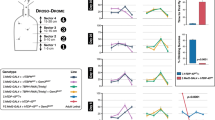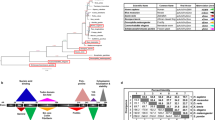Abstract
Spinal muscular atrophy (SMA) is a motor-neuron disorder resulting from anterior-horn–cell death. The autosomal recessive form has a carrier frequency of 1 in 50 and is the most common genetic cause of infant death. SMA is categorized as types I–III, ranging from severe to mild, based upon age of onset and clinical course. Two closely flanking copies of the survival motor neuron (SMN) gene are on chromosome 5q13 (ref. 1). The telomeric SMN (SMN1) copy is homozygously deleted or converted in >95% of SMA patients, while a small number of SMA disease alleles contain missense mutations within the carboxy terminus. We have identified a modular oligomerization domain within exon 6 of SMN1. All previously identified missense mutations map within or immediately adjacent to this domain. Comparison of wild-type to mutant SMN proteins of type I, II and III SMA patients showed a direct correlation between oligomerization and clinical type. Moreover, the most abundant centromeric SMN product, which encodes exons 1–6 but not 7, demonstrated reduced self-association. These findings identify decreased SMN self-association as a biochemical defect in SMA, and imply that disease severity is proportional to the intracellu-lar concentration of oligomerization-competent SMN proteins.
This is a preview of subscription content, access via your institution
Access options
Subscribe to this journal
Receive 12 print issues and online access
$209.00 per year
only $17.42 per issue
Buy this article
- Purchase on Springer Link
- Instant access to full article PDF
Prices may be subject to local taxes which are calculated during checkout
Similar content being viewed by others
References
Lefebvre, S. et al. Identification and characterization of a spinal muscular atrophy determining gene. Cell 80, 155–165 (1995).
Brzustowicz, L.M. et al. Genetic mapping of chronic childhood-onset spinal muscular atrophy to chromosome 5q11.2-13.3. Nature 344, 540–541 (1990).
Melki, J. et al. Gene for chronic spinal muscular atrophies maps to chromosome 5q. Nature 344, 767–768 (1990).
Burghes, A. When is a deletion not a deletion?When it is converted. Am. J. Hum. Genet. 61, 9–15 (1997).
Melki, J. Spinal muscular atrophy. Curr. Opin. Neurol. 10, 381–385 (1997).
Bussaglia, E. et al. A frame-shift deletion in the survival motor neuron gene in Spanish spinal muscular atrophy patients. Nature Genet. 11, 335–337 (1995).
Hahnen, E. et al. Molecular analysis of candidate genes on chromosome 5q13 in autosomal recessive spinal muscular atrophy: evidence of homozygous deletions of the SMN gene in unaffected individuals. Hum. Mol. Genet. 4, 1927–1933 (1995).
Hahnen, E., Schonling, J., Rudnik-Schoneborn, S., Zerres, K. & Wirth, B. Hybrid survival motor neuron genes in patients with autosomal recessive spinal muscular atrophy: new insights into molecular mechanisms responsible for the disease. Am. J. Hum. Genet. 59, 1057–1065 (1996).
Rodrigues, N.R. et al. Deletions in the survival motor neuron gene on 5q13 in autosomal recessive spinal muscular atrophy. Hum. Mol. Genet. 4, 631–634 (1995).
Brahe, C. et al. Frameshift mutation in the survival motor neuron gene in a severe case of SMA type I. Hum. Mol. Genet. 5, 1971–1976 (1996).
Parsons, D.W. et al. An 11 base pair duplication in exon 6 of the SMN gene produces a type I spinal muscular atrophy (SMA) phenotype: further evidence for SMN as the primary SMA-determining gene. Hum. Mol. Genet. 5, 1727–1732 (1996).
van der Steege, G. et al. Apparent gene conversions involving the SMN gene in the region of the spinal muscular atrophy locus on chromosome 5. Am. J. Hum. Genet. 59, 834–838 (1996).
Velasco, E., Valero, C., Valero, A., Moreno, F. & Hernandez-Chico, C. Molecular analysis of the SMN and NAIP genes in Spanish spinal muscular atrophy (SMA) families and correlation between number of copies of CBCD541 and SMA phenotype. Hum. Mol. Genet. 5, 257–263 (1996).
Campbell, L., Potter, A., Ignatius, J., Dubowitz, V. & Davies, K. Genomic variation and gene conversion in spinal muscular atrophy: implications for disease process and clinical phenotype. Am. J. Hum. Genet. 61, 40–50 (1997).
DiDonato, C.J. et al. Deletion and conversion in spinal muscular atrophy patients: is there a relationship to severity? Ann Neurol. 41, 230–237 (1997).
McAndrew, P.E. et al. Identification of proximal spinal muscular atrophy carriers and patients by analysis of SMNT and SMNC gene copy number. Am. J. Hum. Genet. 60, 1411–1422 (1997).
Hahnen, E. et al. Missense mutations in exon 6 of the survival motor neuron gene in patients with spinal muscular atrophy. Hum. Mol. Genet. 6, 821–825 (1997).
Talbot, K. et al. Missense mutation clustering in the survival motor neuron gene: a role for a conserved tyrosine and glycine rich region of the protein in RNA metabolism? Hum. Mol. Genet. 6, 497–500 (1997).
Gennarelli, M. et al. Survival motor neuron gene transcript analysis in muscles from spinal muscular atrophy patients. Biochem. Biophys. Res. Commun. 213, 342–348 (1995).
Lefebvre, S. et al. Correlation between severity and SMN protein level in spinal muscular atrophy. Nature Genet. 16, 265–269 (1997).
Coovert, D. et al. The survival motor neuron protein in spinal muscular atrophy. Hum. Mol. Gen. 6, 1205–1214 (1997).
Liu, Q., Fischer, U., Wang, F. & Dreyfuss, G. The spinal muscular atrophy disease gene product, SMN, and its associated protein SIP1 are in a complex with spliceosomal snRNP proteins. Cell 90, 1013–1021 (1997).
Schrank, B. et al. Inactivation of the survival motor neuron gene, a candidate gene for human spinal muscular atrophy, leads to massive cell death in early mouse embryos. Proc. Natl. Acad. Sci. USA 94, 9920–9925 (1997).
Breiding, D.E., Grossel, M.J. & Androphy, E.J. Genetic analysis of the bovine papillomavirus E2 transcriptional activation domain. Virology 221, 34–43 (1996).
Chen, J.J., Reid, C.E., Band, V. & Androphy, E.J. Interaction of papillomavirus E6 oncoproteins with a putative calcium-binding protein. Science 269, 529–531 (1995).
Author information
Authors and Affiliations
Corresponding author
Rights and permissions
About this article
Cite this article
Lorson, C., Strasswimmer, J., Yao, JM. et al. SMN oligomerization defect correlates with spinal muscular atrophy severity. Nat Genet 19, 63–66 (1998). https://doi.org/10.1038/ng0598-63
Received:
Accepted:
Issue Date:
DOI: https://doi.org/10.1038/ng0598-63
This article is cited by
-
NRF2 has a splicing regulatory function involving the survival of motor neuron (SMN) in non-small cell lung cancer
Oncogene (2023)
-
Heat increases full-length SMN splicing: promise for splice-augmenting therapies for SMA
Human Genetics (2022)
-
The phospho-landscape of the survival of motoneuron protein (SMN) protein: relevance for spinal muscular atrophy (SMA)
Cellular and Molecular Life Sciences (2022)
-
Biodistribution of onasemnogene abeparvovec DNA, mRNA and SMN protein in human tissue
Nature Medicine (2021)
-
Gain of toxic function by long-term AAV9-mediated SMN overexpression in the sensorimotor circuit
Nature Neuroscience (2021)



